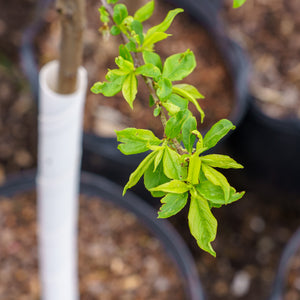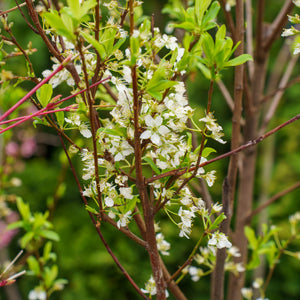The Plum Tree Guide
Plum trees (Prunus spp.) are ornamental and fruiting trees known for their stunning spring blossoms, edible summer fruit, and year-round ornamental value. Their graceful branching, colorful foliage, and manageable size make them ideal for home gardens, small orchards, and multi-season interest plantings. With proper care and site selection, plums reward gardeners with both visual beauty and flavorful harvests.
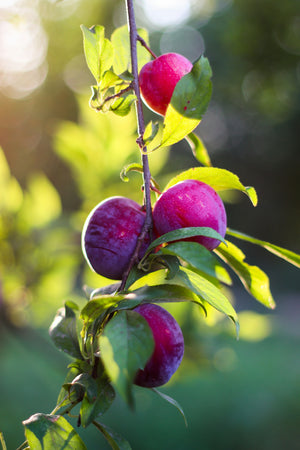
About
The Prunus genus encompasses hundreds of species, with plum trees being one of the most diverse and widely cultivated groups. Native to Europe, Asia, and North America, plums are grown worldwide for both ornamental and edible purposes. Gardeners can choose from fruiting varieties prized for their flavorful drupes or ornamental forms grown for their vibrant spring blossoms and richly colored foliage.
Plums are typically divided into three main categories:
- European Plums (Prunus domestica) are hardy and suited to temperate climates. These trees produce firm, sweet fruit ideal for fresh eating, baking, drying, and preserves. 'Bruce' is a popular cultivar valued for its adaptability and early ripening.
- Japanese Plums (Prunus salicina) are more vigorous and better suited to warmer regions. Their juicy, tender fruit ranges from golden to deep purple and often requires cross-pollination. Cultivars like 'Methley', 'Shiro', and 'Elephant Heart' are widely grown in home orchards.
- Ornamental Plums (Prunus cerasifera) are grown not for fruit but for aesthetic value. These include trees such as 'Thundercloud' and 'Krauter Vesuvius', which feature deep purple foliage and bright pink spring flowers. While some may produce small fruit, it's generally not edible.
Plum trees typically grow between 15 and 25 feet tall and form rounded or upright canopies depending on the cultivar. Their early-season flowers offer one of the first signs of spring and attract pollinators to the garden. Some selections also provide excellent fall foliage, ranging from gold to red.
Plums are among the easiest fruit trees to integrate into ornamental landscapes due to their compact size, attractive habit, and seasonal interest. When grown with proper care and adequate sunlight, they reward gardeners with decades of beauty and productivity.
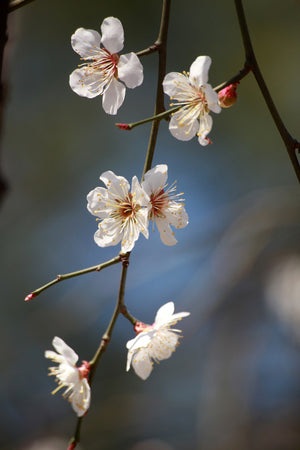
PLANTING
Plums thrive in sunny, well-drained locations with room to spread and develop healthy root systems.
USDA Hardiness Zones: Most plum trees are hardy in Zones 4–9, with Japanese plums preferring the warmer end and European plums suited for cooler areas.
Soil: Well-drained, fertile soils are ideal. Avoid low, soggy areas where root rot can occur. Slightly acidic to neutral pH (6.0–7.0) is preferred.
Sunlight: Full sun is essential for flowering, fruiting, and healthy growth. At least 6 hours of direct light per day is needed.
Watering: Regular watering is needed during establishment. Mature trees are moderately drought-tolerant but benefit from deep watering during fruit development.
Spacing: Most standard plum trees need 15–20 feet of space. Dwarf selections can be spaced 8–10 feet apart.
Planting Time: Plant bare-root trees in early spring or container-grown trees in spring or fall.
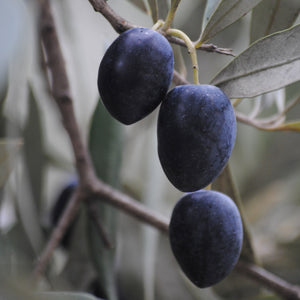
CARE
Watering: Deeply water young trees weekly during the first two years. Older trees need consistent moisture during flowering and fruiting but should not sit in waterlogged soil.
Fertilizing: Apply a balanced fertilizer in early spring before bud break. Avoid excessive nitrogen, which can reduce fruit production.
Pruning: Prune in late winter or early spring to remove dead, damaged, or crossing branches. Train trees to an open center or modified central leader form to promote airflow and sun exposure.
Pests and Diseases: Watch for aphids, plum curculio, and fungal issues like brown rot or black knot. Apply horticultural oils, fungicides, or pruning as needed for control.
Mulching: Maintain a 2–3 inch mulch ring around the base to suppress weeds and conserve moisture, keeping mulch away from the trunk.
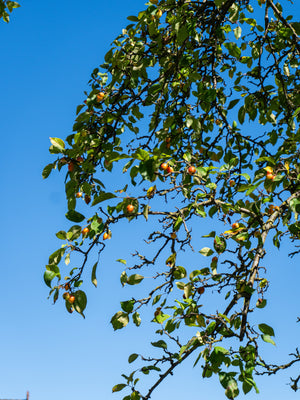
HOW TO USE
Focal Point: Ornamental plums such as Prunus cerasifera 'Krauter Vesuvius' and 'Thundercloud' provide striking deep purple foliage and spring blooms, making them standout focal point trees for lawn plantings or entryways.
Edible Landscapes: Fruiting plums such as Prunus salicina 'Methley' and 'Elephant Heart' blend ornamental beauty with productivity. Use in edible garden designs alongside herbs, blueberries, or perennial vegetables.
Mixed Borders: Plums can anchor a mixed border of flowering shrubs and perennials. Pair with spring bloomers like Forsythia, summer color from Hydrangeas, and ornamental grasses for fall interest.
Cottage and Informal Gardens: Their natural branching and fragrant blossoms lend plums to relaxed garden styles. Plant near paths or seating areas to enjoy the scent and seasonal changes.
Wildlife Gardens: Plum blossoms attract pollinators in spring, and the fruit provides food for birds and mammals if left on the tree.
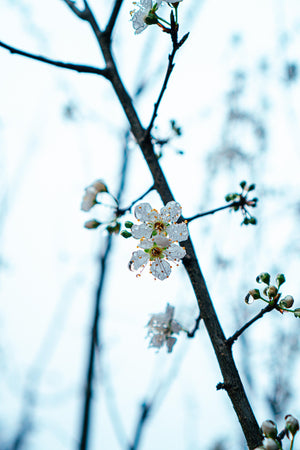
Common Questions
How to prune a plum tree? Prune in late winter or early spring to remove damaged or crossing branches. Shape the canopy to allow sunlight and air circulation.
How to grow a plum tree? Plant in full sun with well-drained soil. Water regularly, fertilize in early spring, and prune annually to maintain structure and health.
How big do plum trees get? Most grow 15–25 feet tall and wide, though dwarf varieties may remain under 10 feet.
What does a plum tree look like? Plum trees have spreading branches, early spring blossoms (white or pink), and either green or purple foliage depending on the variety.
When to prune a plum tree? Prune in late winter or early spring before bud break. Avoid summer pruning to reduce disease risk.
Are plum trees self-pollinating? Some varieties are self-pollinating, like 'Methley,' but most benefit from a second compatible variety nearby for better yields.
When do plum trees bloom? Bloom time depends on the species but generally occurs in early to mid-spring.
How long do plum trees live? With proper care, plum trees typically live 15–30 years. Ornamental types may live slightly longer.
Do plum trees need full sun? Yes, full sun is necessary for abundant blooms, healthy growth, and fruit production.
Conclusion
Plum trees combine beauty and utility in one compact package. Whether you want delicious summer fruit, spring color, or year-round ornamental value, there's a plum tree suited to your garden. With proper siting, care, and thoughtful design, these trees bring seasonal excitement and long-term rewards.
The Plum Collection
Sold Out
Sold Out
Sold Out
Sold Out
Sold Out

